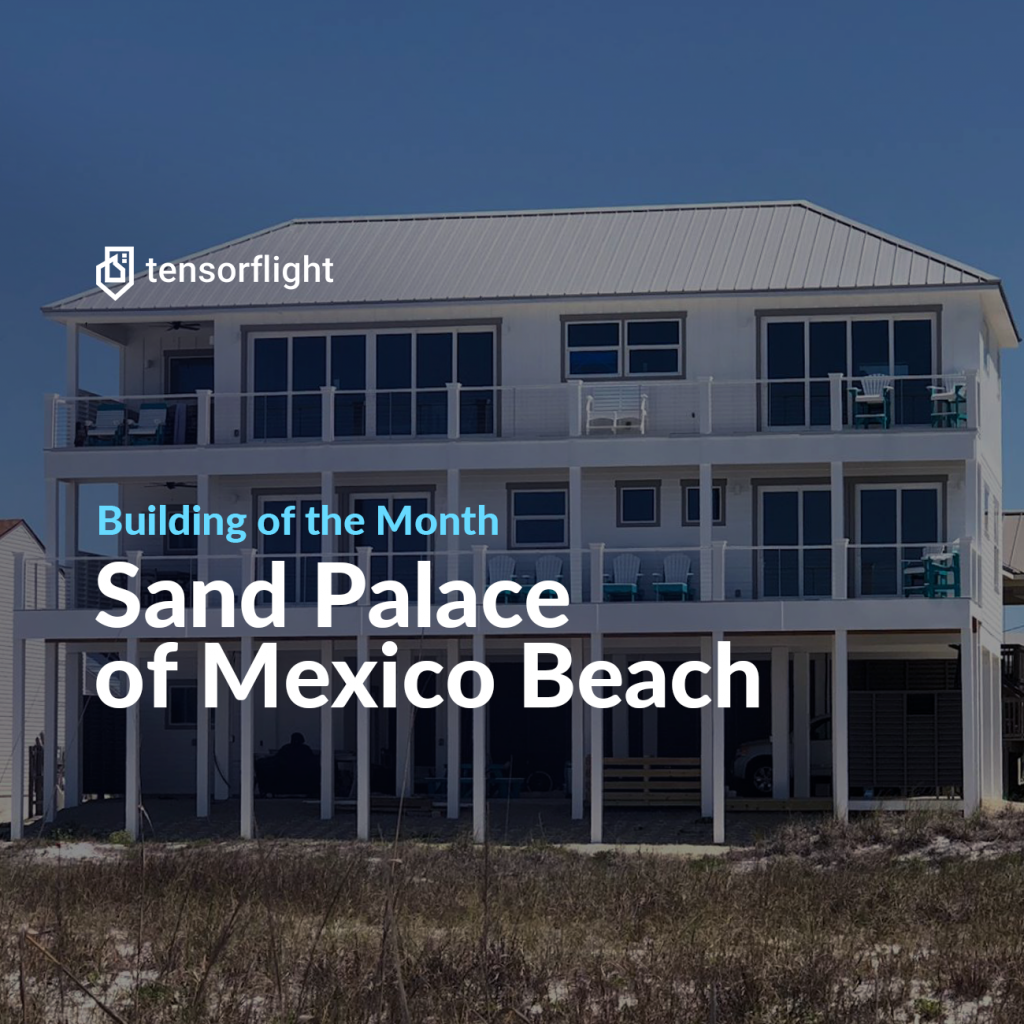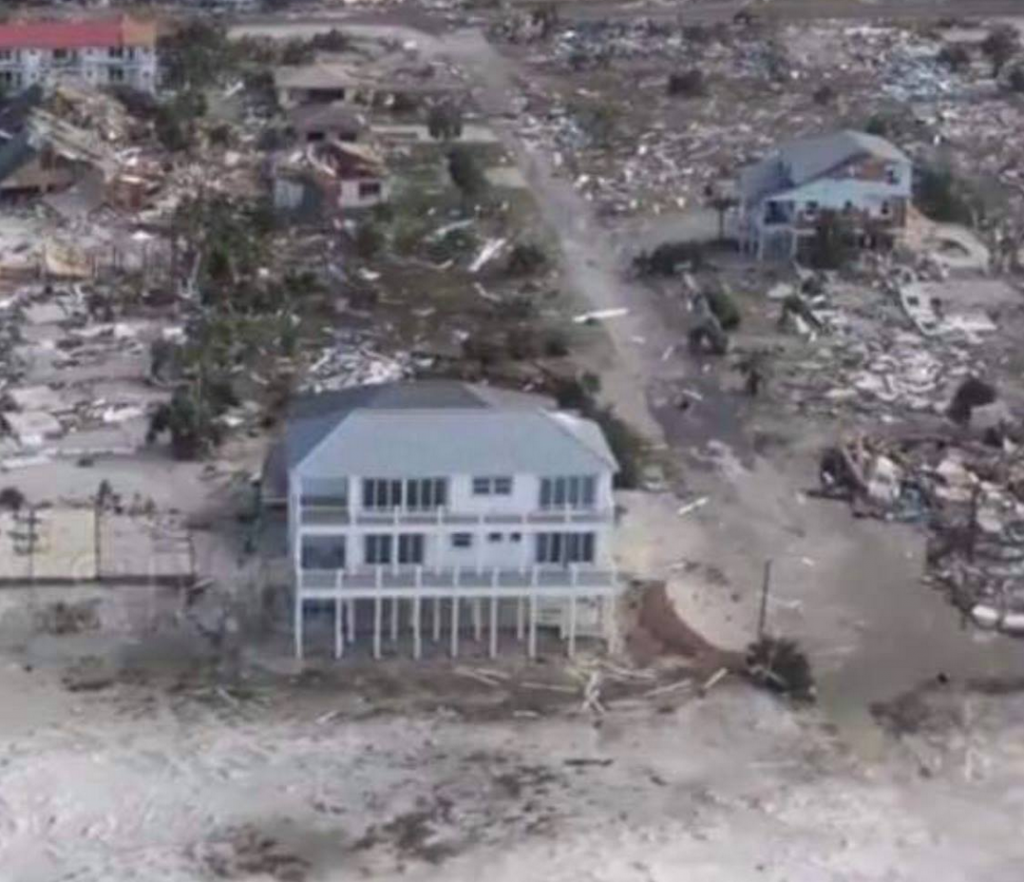Hurricanes are one of the most destructive natural hazards that can affect coastal properties. They unleash powerful winds, devastating storm surges, and torrential rains that cause billions of dollars in damage and loss of life. In 2018, Hurricane Michael was one of the strongest storms ever to hit the United States, with winds of up to 155 mph and a storm surge of up to 14 feet. It ravaged the Florida Panhandle, leaving behind a trail of destruction and despair.

But amid the rubble and debris, one house stood out as a beacon of resilience. It was the Sand Palace of Mexico Beach, a vacation home that was built to withstand nature’s fury. It was one of the few structures that remained intact and habitable after the storm, while most of its neighbors were reduced to splinters and shreds.
How did this house survive such a catastrophic event? What features and materials made it so durable and robust, and what can property insurers and underwriters learn from this remarkable example of engineering and design?
These are some of the questions we will answer in this article. Within this new series of content, we will showcase some of the remarkable buildings in even more detail, providing insights and tips on how property insurers and underwriters can benefit from modern property intelligence solutions, and use Tensorflight’s technology to assess and improve your property data quality and accuracy.
How did the Sand Palace of Mexico Beach survive?
The Sand Palace was built in 2018 by Russell King and his nephew Lebron Lackey, who wanted to create a vacation home that could withstand hurricanes. They consulted with engineers, architects, and contractors to design and construct a house that met or exceeded the most stringent building codes and standards for hurricane-resistant structures. They also incorporated some innovative and extra features that made the house even more resilient and adaptable to changing conditions. The building was exposed to the full force of the wind, water, and debris that Hurricane Michael unleashed. Yet, it did not collapse or sustain major damage. It remained standing and habitable, with only minor cosmetic issues.
The base of the house was raised on stilts so that storm surge could pass underneath without damaging the structure. Storm surge is one of the most dangerous and destructive effects of hurricanes, as it can inundate coastal areas and cause widespread flooding. The Sand Palace’s stilts prevented the storm surge from reaching the main floor of the house, where most of the living spaces and utilities were located. The stilts also reduced the impact of waves and debris that could have eroded or damaged the foundation of the house.
The perimeter walls of the house were made of concrete, a strong and durable material that can resist wind and water forces. Concrete walls can also protect against fire hazards, as they are non-combustible and have a high fire resistance rating. The Sand Palace’s concrete walls were reinforced with steel bars and cables, which added strength and stability to the structure. The walls were also insulated with EPS, which provided thermal comfort and energy efficiency to the house.
The roof of the house was a hip roof that sloped down on all four sides. Hip roofs are better than gable roofs at withstanding pressure from hurricane-force winds because they have less surface area exposed to windward and leeward forces. The roof was also covered with interlocking 26-gauge steel panels that won’t rip apart or fly away in a hurricane. The steel roof has a tight seal that prevents water intrusion and protects against fire hazards. The roof was attached to the walls with hurricane ties to secure the roof trusses and prevent them from being lifted off by strong winds. The soffits were closed with fiber cement to prevent wind from entering the attic space and creating uplift pressure on the roof deck. The overhangs were kept small to reduce the amount of potential uplift force on them by the wind.
The doors and windows of the house were custom-made in Ocala, Florida, to meet the 140 mph, 4-pound-projectile Miami-Dade County criteria. This means that they can resist impacts from flying debris and wind pressure that could otherwise break or shatter them. The owners also limited the number of windows and doors to minimize the risk of a breach in the building envelope. They also removed a balcony on the east side of the house which could have been a weak point.
The house was built to comply with or exceed the state code for hurricane-resistant structures, which required that houses have to be built to withstand 120-mph winds. However, it withstands about 240- to 250-mph winds, which is twice as strong as the code requirement. The owners and engineers used multiple factors of safety to account for any construction errors, unprecedented storm events, and more to provide an exceptional design in the event of an unforeseen act of nature.

Lessons learned from the Sand Palace
Property insurers and underwriters can learn a lot from this example of engineering. This house shows how building codes and standards can make a difference in the resilience and performance of properties during a hurricane event. It also shows how innovative and extra features can enhance the durability and robustness of the structure.
Building codes and standards are not enough. They are the minimum requirements for safety and quality, but they may not account for all the possible scenarios and risks that a property may face. Property owners and insurers should consider going beyond the code and adopting more stringent and rigorous criteria for building design and construction, such as the Miami-Dade County criteria or the Fortified Home program. These can help reduce the vulnerability and damage of properties to wind, water, fire, and debris impacts.
Building features and materials matter. The structural features and characteristics of a property can have a significant impact on its resilience and performance during a hurricane event. Property owners and insurers should pay attention to the construction type, roof shape, roof material, roof condition, solar panels, skylights, pools, decks, and other features of the buildings they own or insure. These features can affect the wind resistance, water resistance, fire resistance, energy efficiency, thermal comfort, and mold resistance of the property. Property owners and insurers should choose features and materials that can enhance these qualities and protect the property from natural hazards.
What can property insurers and underwriters learn from its engineering and design?
The Sand Palace serves as an exemplary case study for property insurers and underwriters, showcasing the importance of investing in innovative engineering and design. By learning from this remarkable example, insurers can encourage property owners to construct and maintain resilient properties, ultimately reducing the financial burden of hurricane-related claims and ensuring the safety and security of coastal properties in the face of nature’s fury. Property intelligence becomes essential – it provides valuable insights into the structural features and characteristics of the buildings, what we’ve explained in detail in our previous article – Property Insights in the Hurricane Seasons.

